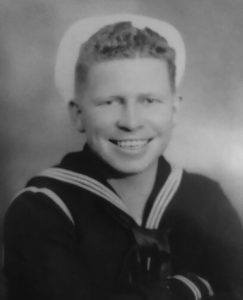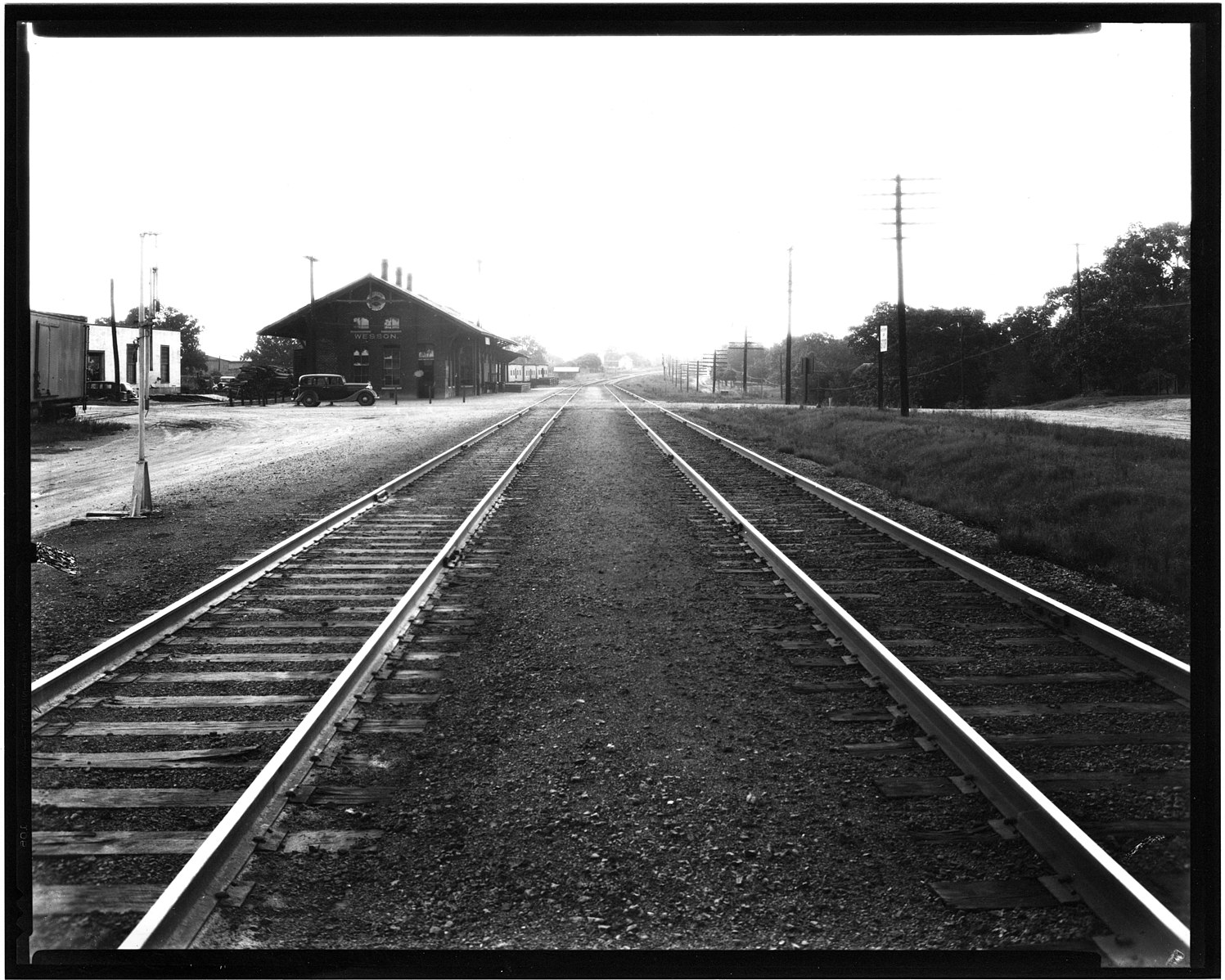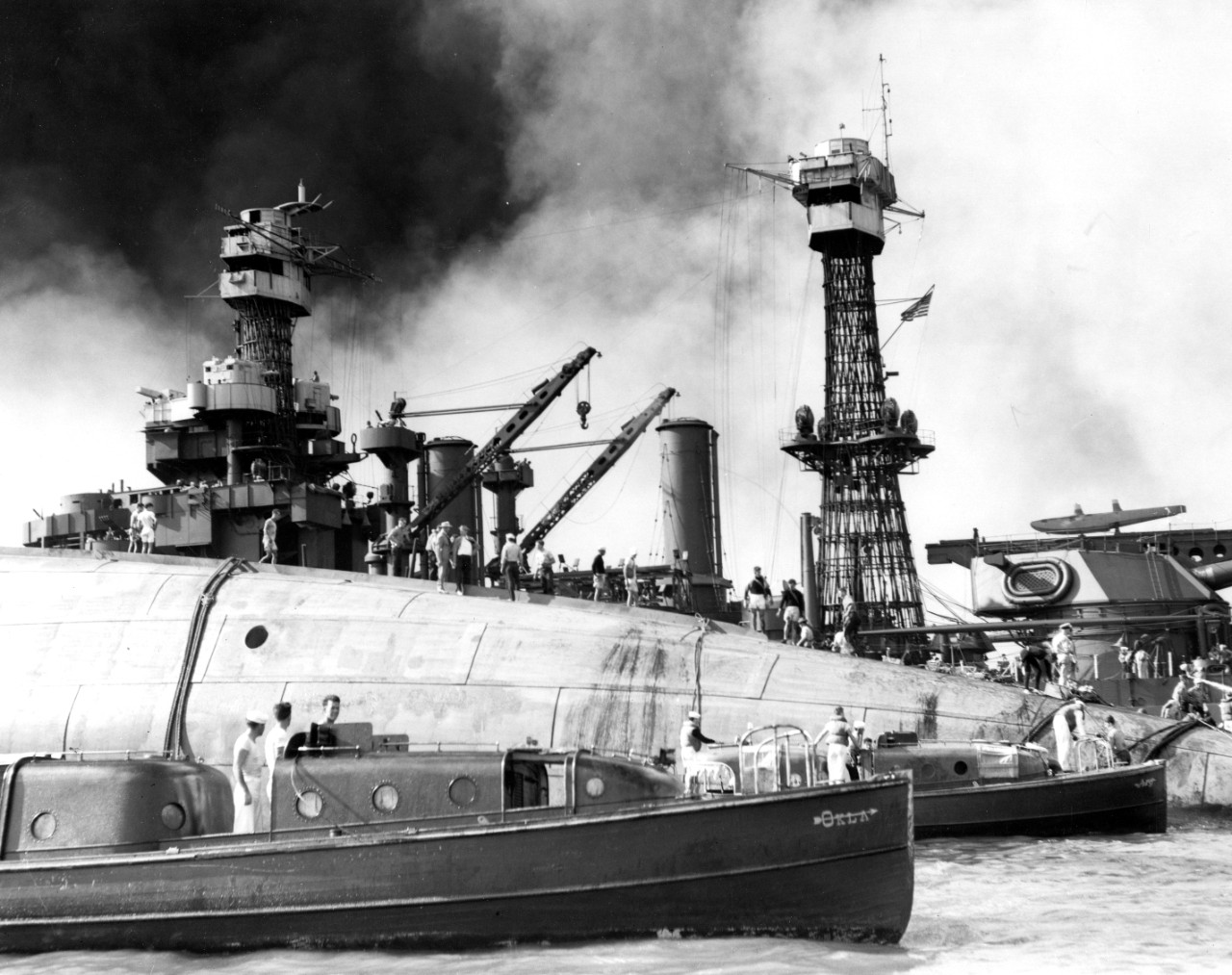Fireman First Class Jim Hal Johnston

- Unit: USS Oklahoma
- Service Number: 2744861
- Date of Birth: February 8, 1918
- Entered the Military: July 31, 1940
- Date of Death: December 7, 1941
- Hometown: Wesson, Mississippi
- Place of Death: Pearl Harbor, Hawai’i
- Award(s): Purple Heart
- Cemetery: Court 3, Courts of the Missing. National Memorial Cemetery of the Pacific, Honolulu, Hawai’i
Mentored by Mr. Craig Wood
Starkville High School
2020-2021
Early Life
Fireman First Class Jim Hal Johnston was born on February 8, 1918. He grew up in Wesson, Mississippi, as the second youngest child. He had two older sisters, Mary Ella and Fannie, and a younger brother, Frank. His mother, Clara, stayed at home to take care of her children, and his father, Frank, worked as a section foreman for the Illinois Central Railroad.
Johnston and his siblings attended high school in the Wesson Separate School District. Following this, he completed one year of college. He then began working on the Illinois Central Railroad as a section hand until he enlisted in the U.S. Navy in 1940.


Homefront
Mississippi Mills Closure
Historically, the towns that made up Copiah County helped better the quality of life for the surrounding areas by serving as a cultural, social, and religious hub. The Mississippi Mills employed many people in Wesson until it closed in 1910. The mill’s closure caused a large decrease in population and, in a chain reaction, many other businesses closed as the economy and population declined. Located between Jackson and New Orleans, Wesson existed as the largest city on the Illinois Central Railroad line before the Mississippi Mills liquidation. Within a year of its closing, the population went from roughly 5,000 to 1,000 people.
The Wesson citizens who remained became dairy farmers. Later, new industries came to the area. A box factory and a canning factory were established in Copiah County. Copiah County produced more vegetables than any other country in Mississippi. In 1927, the county reached its highest number of vegetable shipments.
New Jobs for the People of Mississippi
More than 237,000 Mississippians enlisted in the military during World War II. Losing male workers to the front lines created many job openings that resulted in a shift from sharecropping to industry jobs. Mississippians began to make more money in a week working at a shipyard than they did in a whole year before the war.
From 1940 to 1945, the Mississippi farm population decreased by 26 percent, and the number of farms decreased by ten percent. During the war, 30 percent of all white tenants and 14 percent of all African American tenants left farms.

Military Experience
Early Military Life
At the age of 23, Johnston enlisted in the U.S. Navy as an apprentice seaman in New Orleans, Louisiana. On August 5, 1940, Johnston traveled to the Naval Training Station in San Diego, California. Several months later, on October 16, 1940, he attended machinist school for 20 weeks in Norfolk, Virginia. Johnston graduated sixth out of 42 in his class. On May 13, 1941, he reported to the USS Oklahoma in Pearl Harbor, Hawaiʻi.
Johnston received two promotions throughout his military career. On July 1, 1941, he earned a promotion to Fireman Second Class and then to Fireman First Class four months later, on November 1, 1941.
USS Oklahoma
On the morning of December 7, 1941, the Japanese forces attacked Pearl Harbor, ultimately sinking the USS Oklahoma and eight other ships. Eight torpedoes hit the USS Oklahoma within the first ten minutes of the attack, causing the ship to capsize. When the ninth torpedo hit, the battleship sank to the muddy floor of Pearl Harbor.
Docked on Battleship Row, the USS Oklahoma took the brunt of the attack. The Japanese forces employed dive-bombers, fighter-bombers, and torpedo planes during the attack. Out of the 2,402 U.S. casualties at Pearl Harbor, 429 served on the USS Oklahoma.
Interment
At the time, the U.S. military identified close to 400 sailors and Marines from the USS Oklahoma. However, most service members were not identified at the time. Many of these men were buried in the National Memorial Cemetery of the Pacific in Honolulu, Hawaiʻi, as unknown servicemembers.
In 2015, the Defense POW/MIA Accounting Agency disinterred the unknowns’ remains. Due to the progress in the field of forensics, DPAA identified Johnston’s remains using DNA samples from his living relatives.
On December 7, 2015, the 75th anniversary of the attack on Pearl Harbor, Johnston was finally laid to rest in his hometown of Wesson, Mississippi, at the Wesson Cemetery.



Eulogy
At 7:55 in the morning on December 7, 1941, the Japanese forces launched a surprise attack on Pearl Harbor. The next day Congress declared war on Japan, and the United States officially entered World War II. The attack resulted in 2,403 casualties. One of these casualties was Fireman First Class, Jim Hal Johnston. Although Johnston only spent a little over a year in the Navy, his loyalty and dedication meant so much.
After Johnston’s remains were identified in 2015, he was welcomed home to Copiah County by individuals from all over the state. As law enforcement escorted him to his final resting spot, American flags flew in the wind.
The fight for freedom is long from over, but Johnston’s sacrifice for his country has not gone unnoticed. Along with the other 2,402 servicemen that died defending our country, Johnston has gone down in history and will never be forgotten.

Reflection
The Sacrifice For Freedom®: World War II in the Pacific Student Teacher Institute was a wonderful experience over the past two years. The impact this program had on me was something I never expected. My research skills grew tremendously, and I gained a deeper understanding of Hawaiian history and World War II. I met so many amazing students and teachers through this program as well. I am so thankful I was able to participate in this life-changing experience. Spending the night on the USS Missouri was by far one of the trip’s highlights. Being able to stand where so many sailors did many years ago and get a small taste of what their lives were like was something I will never forget. Standing on the deck where the Japanese surrendered to end World War II made history come to life for me. I was no longer reading out of a textbook; I was experiencing it first-hand. This moment changed how I will view history forever.
Visiting the USS Oklahoma Memorial, where my Silent Hero is memorialized, was a very special moment for me. I loved how each sailor had their own post that represented the crew members standing at attention. After spending so much time researching, it was almost like I was finally getting to meet Jim Johnston. It was a moment I will remember and cherish for the rest of my life.
The word sacrifice has a whole new meaning to me after this experience. Johnston, along with countless others, gave their lives to ensure our freedom. Many of these brave men and women to this day do not have their stories being told. This experience has taught me to take the time to remember and never forget the ones who made this sacrifice.
Bibliography
Primary Sources
Apel, Therese. “Mississippi Sailor Killed at Pearl Harbor Coming Home.” The Clarion-Ledger [Jackson, Mississippi], November 22, 2016. www.clarionledger.com/story/news/local/2016/11/21/mississippi-sailor-killed-pearl-harbor-comes-home/94231784/.
Archambeault, Lawrence. USS Oklahoma (BB-37). Photograph. December 16, 1920. Naval History and Heritage Command (S-526-N). www.history.navy.mil/content/history/nhhc/our-collections/photography/numerical-list-of-images/nhhc-series/s-file/s-526-n-uss-oklahoma–bb-37-.html.
Cooper, Forrest Lamar. Old Mills (upper). Mississippi Mills (lower), Wesson, Miss. Postcard. Mississippi Department of Archives and History (PI/1992.0001). da.mdah.ms.gov/series/cooper/detail/19364.
Copiah County. List of Educable Children. 1933. State of Mississippi Department of Education. Mississippi Department of Archives and History. da.mdah.ms.gov/educablechildren/Copiah/1933/21.
Copiah County. List of Educable Children. 1937. State of Mississippi Department of Education. Mississippi Department of Archives and History. da.mdah.ms.gov/educablechildren/Copiah/1937/141/.
Hamilton, Sr., Luther M. Illinois Central Railroad depot at Wesson, Mississippi. Photograph. Mississippi Department of Archives and History (PI/1994.0004). da.mdah.ms.gov/series/hamilton/detail/914.
“Historic and Architectural Resources of Copiah County, Mississippi.” Mississippi Department of Archives and History. Updated October 5, 1995. Accessed December 5, 2020. www.apps.mdah.ms.gov/t_nom/Historic%20and%20Architectural%20Resources%20of%20Copiah%20County,%20Mississippi.pdf.
Jim Hal Johnston. Headstone and Interment Records for U.S. Military Cemeteries on Foreign Soil, 1942-1949. ancestry.com.
Jim Hal Johnston, Individual Deceased Personnel File, Department of the Army.
Jim Hal Johnston, Official Military Personnel File, Department of the Navy, Records of the Bureau of Naval Personnel, RG 24, National Archives and Records Administration – St. Louis
Jim Hal Johnston. U.S. Navy Casualties Books, 1776-1941. Digital Images. ancestry.com.
Jim Hal Johnston. World War II and Korean Conflict Veterans Interred Overseas. ancestry.com.
Jim Hal Johnston. World War II Navy, Marine Corps, and Coast Guard Casualties, 1941-1945. Digital Images. ancestry.com.
Jim Hal Johnston. World War II Navy Muster Rolls, 1938-1949. ancestry.com.
Jim Hal Johnston. Veterans Administration Master Index, 1917-1940. ancestry.com.
Mississippi. Copiah County. 1930 U.S. Census. Digital Images. ancestry.com.
Mississippi. Copiah County. 1940 U.S. Census. Digital Images. ancestry.com.
Pearl Harbor Attack, 7 December 1941. Photograph. December 7, 1941. Naval History and Heritage Command (80-G-19941). www.history.navy.mil/content/history/nhhc/our-collections/photography/us-navy-ships/battleships/oklahoma-bb-37/80-G-19941.html.
Secondary Sources
Crawford, Rob. “Cotton Mills, Overview.” The MSGenWeb Project. Updated May 30, 2014. Accessed September 20, 2020. www.msgw.org/copiah/Resources/Reference/History/Communities/Mills/mills.html.
“Jim Hal Johnston.” Find a Grave. Updated October 6, 2011. Accessed December 5, 2020. www.findagrave.com/memorial/77749561/jim-hal-johnston.
“Jim Hal Johnston.” Find a Grave. Updated November 20, 2016. Accessed December 5, 2020. www.findagrave.com/memorial/172993427/jim-hal-johnston.
Ray Skates, John. “World War II.” Mississippi Encyclopedia.Updated April 15, 2018. Accessed December 5, 2020. mississippiencyclopedia.org/entries/world-war-ii/.
“Sailor Killed in World War II Accounted For (Johnston).” Defense POW/MIA Accounting Agency. Updated August 16, 2016. Accessed December 5, 2020. www.dpaa.mil/News-Stories/Recent-News-Stories/Article/915779/sailor-killed-in-world-war-ii-accounted-for-johnston/.
“Service Member: F1C Jim H. Johnston.” Defense POW/MIA Accounting Agency. Updated August 12, 2016. Accessed December 5, 2020. dpaa.secure.force.com/dpaaProfile?id=a0Jt000001DKIpUEAX.
“The USS Oklahoma.” Oklahoma Historical Society. Accessed October 5, 2020. www.okhistory.org/learn/ussok.
“USS Oklahoma casualties identified.” National Park Service. Accessed December 5, 2020. www.nps.gov/valr/uss-oklahoma-casualties-identified.htm.
“USS Oklahoma Sailor From World War II Accounted For (Johnston).” Defense POW/MIA Accounting Agency. Updated November 30, 2016. Accessed December 5, 2020. www.dpaa.mil/News-Stories/News-Releases/Article/1014807/uss-oklahoma-sailor-from-world-war-ii-accounted-for-johnston/.

